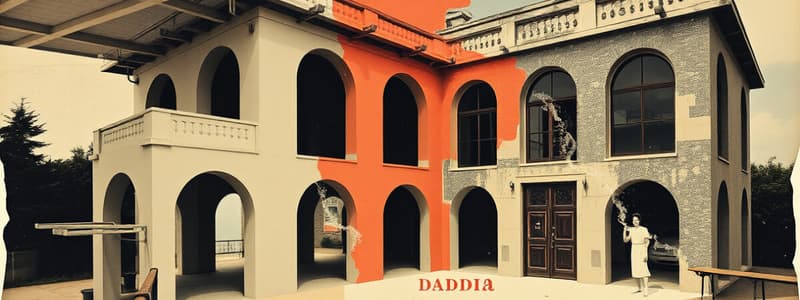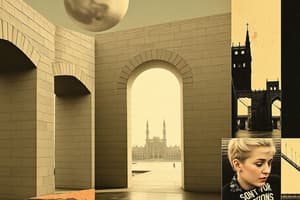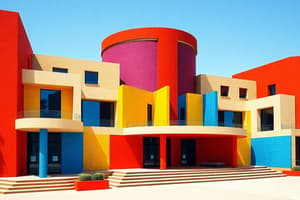Podcast
Questions and Answers
What aspect of a form refers to its direction relative to the ground plane or the observer?
What aspect of a form refers to its direction relative to the ground plane or the observer?
- Surface
- Orientation (correct)
- Visual inertia
- Shape
Which term describes the degree of stability and concentration of a form?
Which term describes the degree of stability and concentration of a form?
- Orientation
- Surface
- Shape
- Visual inertia (correct)
Which of the following is not considered a primary shape in architecture?
Which of the following is not considered a primary shape in architecture?
- Hexagon (correct)
- Triangle
- Square
- Circle
What defines a cylindrical surface?
What defines a cylindrical surface?
Which characteristic is essential for recognizing and categorizing forms?
Which characteristic is essential for recognizing and categorizing forms?
What type of surface is generated by sliding a plane curve along a straight line?
What type of surface is generated by sliding a plane curve along a straight line?
Which of the following shapes is defined as having four equal sides and four right angles?
Which of the following shapes is defined as having four equal sides and four right angles?
What features characterize ruled surfaces?
What features characterize ruled surfaces?
What is a key characteristic of a ruled surface?
What is a key characteristic of a ruled surface?
Which surfaces are formed from the intersection of planes resulting in parabolas and ellipses or parabolas and hyperbolas?
Which surfaces are formed from the intersection of planes resulting in parabolas and ellipses or parabolas and hyperbolas?
How is a hyperbolic paraboloid generated?
How is a hyperbolic paraboloid generated?
What describes the curvature of saddle surfaces?
What describes the curvature of saddle surfaces?
What type of curve generates a parabola?
What type of curve generates a parabola?
What is the primary function of architectural form?
What is the primary function of architectural form?
Which visual property of form determines the amount of space it occupies?
Which visual property of form determines the amount of space it occupies?
How does color influence the perception of a form?
How does color influence the perception of a form?
What aspect defines the relational property of position in forms?
What aspect defines the relational property of position in forms?
Which characteristic of shape allows us to identify and categorize forms?
Which characteristic of shape allows us to identify and categorize forms?
What visual property of form defines how a surface interacts with light?
What visual property of form defines how a surface interacts with light?
In the context of architectural forms, what does scale refer to?
In the context of architectural forms, what does scale refer to?
Which of the following is NOT considered a property of form?
Which of the following is NOT considered a property of form?
Flashcards are hidden until you start studying
Study Notes
Architectural Form
- Architectural form acts as the interface between mass and space, shaping the interaction between structures and their surroundings.
- Form involves the arrangement and coordination of elements, creating a coherent visual impression.
Shape
- Shape refers to the characteristic outline of a form, crucial for identification and categorization.
- Key examples of forms include the pyramid, cube, and sphere, with corresponding shapes like circle, triangle, square.
Visual Properties of Forms
- Size: Concerns the physical dimensions—length, width, and depth—affecting proportions and contextual scale.
- Color: Influences visual perception through hue, saturation, and tonal value, distinguishing forms from their environment and affecting visual weight.
- Texture: Defines visual and tactile qualities, affecting light reflection or absorption based on the arrangement of a form's parts.
Relational Properties of Forms
- Position: The location of a form in relation to its environment and visual field.
- Orientation: The directional alignment of a form concerning the ground and other forms.
- Visual Inertia: Refers to a form's perceived stability and concentration, influenced by geometry and orientation.
Shape in Architecture
- Shapes include floor, wall, and ceiling planes, as well as door and window openings, contributing to spatial enclosure and building silhouette.
Primary Shapes
- Circle: All points are equidistant from a fixed point, forming a plane curve.
- Triangle: A plane figure with three sides and three angles.
- Square: A plane figure with four equal sides and right angles.
Surfaces
- Surface: Represents a two-dimensional figure or a boundary of a three-dimensional solid.
Types of Surfaces
- Cylindrical Surfaces: Created by sliding a straight line along a plane curve, can be circular, elliptic, or parabolic.
- Translational Surfaces: Formed by moving a plane curve along a straight line.
- Ruled Surfaces: Generated through the movement of a straight line, simpler to construct.
- Rotational Surfaces: Created by rotating a plane curve around an axis.
- Paraboloids: Surfaces intersected by planes yield parabolas and ellipses or hyperbolas.
- Parabolas: Generated by a moving point equidistant from a fixed line and point.
- Hyperbolic Paraboloids: Created by sliding parabolas with different curvatures.
Curved Surfaces
- Saddle Surfaces: Exhibit dual curvature, acting as arch-like structures and may demonstrate beam behavior if unassisted at the edges.
Example of Innovative Design
- Walt Disney Concert Hall in Los Angeles by Frank Gehry exemplifies complex architectural forms utilizing varied surfaces and shapes.
Studying That Suits You
Use AI to generate personalized quizzes and flashcards to suit your learning preferences.




